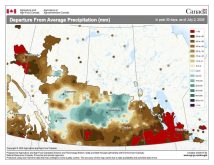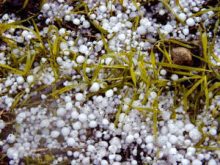Southwest Region
Very few showers during past week and over the weekend. Some spotty showers in Ninette at 12mm and Miniota at 9mm. Daytime temperatures were normal, but nights colder and below zero in most of areas. Frost damage to crops minimal, as most of sensitive crops are not fully emerged yet. Overall seeding is 70-75 per cent done in the region. Many growers have finished seeding with the favourable non-stop seeding season.
Germination and emergence of crops has been slow due to cooler conditions. Moisture has become a limiting factor in most of areas for seed germination.
Read Also

Thunderstorms and straight-line winds
Straight-line winds in thunderstorms can cause as much damage as a tornado and are next on our weather school list exploring how and why severe summer weather forms.
Weed growth is slow, but coming along as weather conditions are getting warmer. Pre-seed herbicide applications were limited due to cool temperatures and limited weeds, but now there are some pre- emergence spray applications happening.
Seeding of spring wheat and other cereals is 90 per cent done with early seeded crop emerging. Emergence looks very even but in need of moisture.
Winter wheat and fall rye continue to advance, however lack of moisture seems to be stunting growth. Some in crop weed control has begun.
Peas are emerging and growth has been slow due to cool conditions Canola seeding is 70 per cent complete with some early seeded canola at the cotyledon stage. Canola seeded in the past week, in most fields, is sitting in dry soil. Some reports of flea beetles, but no reports of spraying.
Soybean planting about 50 per cent complete with the majority of crop planted this past week. Most fields being rolled following seeding, as topsoil conditions are dry in most of the areas.
Grain and silage corn seeding about 70 per cent complete with early seeded corn emerging.
Forage growth remains slow. Precipitation was welcomed, but for the most part was not enough to make much of a difference. More cattle are going to pasture as feed supplies run out. Pastures are not ready and if weather does not improve, they will not sustain for livestock long enough.
Northwest Region
Cool weather continued through the week with overnight frost as the thermostat dipped below zero. The weather warmed up by the end of the weekend with temperatures in the mid 20’s. There was rain around Swan River and The Pas mid week with amounts ranging from 5-13 mm. In spite of the rain, there was good seeding progress in most of the region. Soil moisture conditions throughout the region rated as good with the exception of the east side of the region where conditions remain dry and they are hoping for rain.
Overall seeding progress estimated at 75 per cent complete with the exception of The Pas, where spring operations are just underway. Seeding of spring wheat is nearing completion at 95 per cent planted with the earliest planted fields starting to emerge uniformly. Canola is 70 to 90 per cent complete. Seeding of peas is generally complete and emergence was noticeable with the warmer temperatures. Soybean seeding is underway with 25 to 30 per cent planted. In-crop herbicide applications are just starting on the earlier seeded crops as timing and conditions allow. Insect activity has not been an issue.
Low temperatures and moisture have limited forage growth throughout the Northwest area. Some cattle out on pastures with supplemental feed being required. Corn silage seeding progressing well. Dugouts are limited in capacity and require rain for recharge. Alfalfa fields showing slow growth as well.
Central Region
Scattered showers mid week brought up to 9 mm of rainfall in the Portage and Morden areas. Otherwise limited to no meaningful precipitation received. Soil moisture has been good going into seeding, now the top soil is getting dry. Rain needed to replenish topsoil and sub soil moisture.
Cooler temperatures prevailed with night-time temperatures still dipping to negative values. The later part of the week brought warmer day temperatures with night-time temperatures staying above zero. With continued dry and warmer temperatures, seeding and fertilizer operations progressed and many growers are done. Pre-seed herbicides applied before some canola and soybean crops. Pre- emergence weed burn-off occurring as conditions allow. Very strong winds on the weekend is making it challenging to spray fields with herbicides.
Overall seeding considered 90 per cent complete and expected to be done this week if conditions remain dry.
Good seeding progress made on field peas, wheat, oats and barley; now considered 100 per cent complete. Earliest planted cereals are in the 2 to 3 leaf stage and more is emerging slowly. Corn has been going in steadily with some producers in the northwestern part of the Central region close to completion. Some low-lying flooded areas along the Red River are drying up and seeding is those areas is progressing as topsoil dries up.
Canola, flax and sunflower seeding has become the focus in the last week. Planted acres of canola is at 90 to 95 per cent; sunflowers at 85 per cent.
Potato planting continues in the Morden, Portage and Carberry areas at 95 to 100 per cent complete.
Soybean seeding has been steady as soil temperatures have warmed up, with 90 per cent completed. Field beans planting is 40 to 60 per cent complete in the region.
Winter wheat, fall rye and perennial ryegrass fields are tillering to elongating with warmer weather, but need rain to encourage growth.
Early crop scouting has found the odd cutworm and some striped flea beetles. Diamondback moth traps set up and showing zero above the escarpment and a few in the Red River Valley traps.
Hay and pastures are greening up, but need rain soon to stimulate growth and yield. Cattle being moved onto pastures, but many pastures are still 7 to 10 days away from having adequate grass to meet cattle requirements. Producers need to be careful not to turn cattle out to pasture too early without supplementation if there not adequate re-growth. 2018 overgrazed pastures will be slower to re-grow this spring. Dugouts not fully recharged, ranging from 50 to 90 per cent with an average of 75 per cent. Dry subsoil is drawing down surface water levels and causing drops in sloughs and dugouts. Livestock water supplies are adequate, but need rain to maintain. Feed supplies are very limited.
Eastern Region
Precipitation received between 2 to 10mm last week. Warmer temperatures helped to raise the average soil temperatures at seeding depth to 110 C. Soil moisture conditions on cropland rated as adequate to very short. Soil moisture conditions of hay and pasture land rated as adequate to very short. Reports of light frosts, but with no sensitive crops emerged yet, there was very little damage.
Overall spring seeding estimated at 85 per cent complete with seeding expected to complete by the end of this week. Winter wheat fields are looking good with plants in the 4 leaf, 2 to 3 tiller stage. Spring wheat seeding is wrapping up, with cereals continuing to emerge with some fields in the 2 leaf stage. In general, fields are looking good but reports in some areas of spotty emergence due to cool wet soils.
Corn planting estimated at 95 per cent complete. Corn planting expected to wrap up this week across much of the region. Canola planting estimated at 80 to 90 per cent complete. Many fields at cotyledon stage or emerging.
Many soybean acres planted this week, with warm temperatures and estimated at 80 per cent complete. Sunflower planting estimated at 95 per cent complete. With seeding winding down, producers hoping the rain in the forecast holds true. All planted acres would benefit greatly from a soaking rain to aid in germination and establishment.
Hay field conditions rated as 50 per cent fair to 40 per cent poor and 10 per cent very poor. Pasture conditions rated at 40 per cent fair to 30 per cent poor to 30 per cent very poor. Fertilization of hay and pasture continues. Producers are hoping for rain. Pasture growth is very slow and producers are moving livestock to pasture as they are running out of feed. Some producers with extra feed are feeding on pasture. Livestock water rated as 100 per cent adequate. Dugouts are 50 per cent full.
Interlake Region
Cooler than normal temperatures have continued, with welcome warm weather at the end of the reporting week. All parts of the region had overnight frost events. Some day temperatures got up to 26°C, but average range for the previous week remains at 8 to 9°C. Trace rainfall, with most areas receiving 6 to 8mm; highest amounts of 12 mm at Fisherton and Moosehorn. Producers concerned about the lack of precipitation in all parts of the region. Growing degree days and precipitation are both well below normal for this time of year.
Seeding continues, with many complete and all at least 50 per cent done. Overall seeding average is 70 to 90 per cent and generally more advanced than usual. Most report good seedbed conditions; spring tillage has dried out the soil surface where undertaken. Timely rains needed to support all crops, as all soils are dry below the top 6 inches. Seeds of later seeded crops are swelling and germinating where moisture is sufficient. Shallow seeded crops, canola in particular, is often sitting in dry soil.
Peas and fababeans are emerging. The majority of cereals are in, estimated at 85 to 100 per cent complete. Spring wheat is emerging to one leaf, some early 2 leaf. Emergence rated as fair to good, a result of cool temperatures and dry soils. Oats are emerging to one leaf. Most corn, both grain and silage is seeded, with emergence started.
Some have chosen to seed soybeans before canola. Producers want to avoid flea beetle pressure associated with slow germination due to cold soils, as seen in recent years. Canola estimated at 70 to 95+ per cent complete. No reports of frost injury, as little has emerged.
Soybeans estimated at 60 to 90+ per cent complete; corn at 90+ per cent complete. Silage corn is 50+ per cent done. Some grain corn can be chopped if feed needs continue to be a concern.
Greenfeed acres reported to be up significantly, with 40 to 60+ per cent complete. Forage oat and barley varieties in short supply with increased acres. Winter survival of perennial crops seems to be good, with slow growth under cool temperatures.
Weeds have been slow to grow, but wild oats are emerging to one leaf plus, broadleaf weeds emerging and dandelions evident. Some herbicide applications being made.
Diamondback moth traps are out with minimal numbers. Striped flea beetles being found in the traps. Volunteer canola is seeing heavy flea beetle pressure.
Forage availability is a concern for the region. Pastures were generally overgrazed last fall, compounding concerns. Regrowth has been slow with cold conditions. Alfalfa has stretched to five inches, but grasses are slower than normal. It should be some time before cattle moved out; some pastures are being stocked due to exhausted hay supplies. This will further stress pastures. High costs and low feed availability are contributing factors. Rain and warmer temperatures needed for regrowth. Native hay supplies are at risk due to poor moisture recharge.
Dugout levels are below normal, and sometimes dry. Water supply rated as 90 per cent adequate, but rain needed.


















